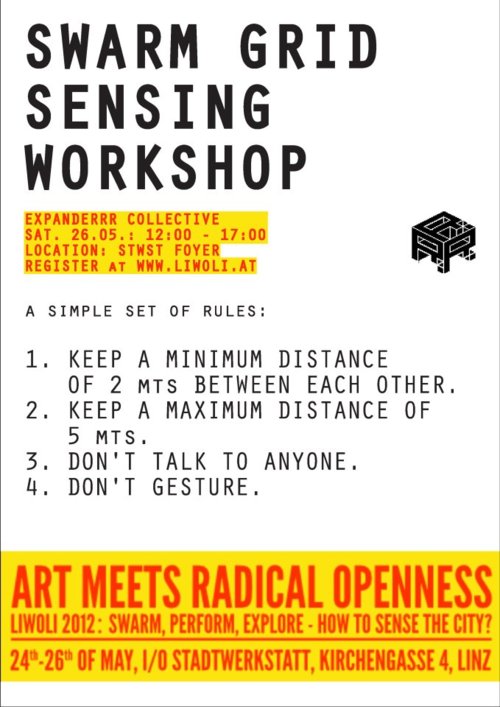
A Workshop by Expanderrr Collective.
Frequently, the concept of swarming is utilized to examine and define rule sets or algorithms that forecast individual behavior in particular situations, especially in public spaces, and how one’s self-perception is molded by a set of rules governing swarming behavior.
In our case, we adopted the concept of swarming as a foundational framework, enriching it to collect individual perspectives and capture social and personal feedback in response to our collective actions. This approach was employed within the context of the LIWOLI (Linux Week Linz) Festival 2012, which was a festival dedicated to art, hacktivism, and open cultures.


The workshop comprised three phases:
Phase I introduced swarming practices and the concept of city swarming as a tool for social sculpture, challenging the power and conditions that shape behavior in various types of public spaces. This phase involved developing a series of swarming «performances» in public spaces, including the decision-making process for the rule sets that govern swarming behavior and, subsequently, the collective behavior of the swarm.
Phase II involved the swarming performances themselves. During these performances, we acted as a swarm, following the organizational rules that shaped or influenced our actions in the public spaces we swarmed. This phase also focused on the sensory aspect. Swarm members assessed their internal emotions, reactions influenced by the swarm, and observed certain qualities and conditions in the public spaces, which were identified during Phase I for observation and detection during the swarming.
Phase III revolved around collecting, comparing, and discussing the outcomes of the swarming and the sensory experiences of the swarm members. The results were presented and discussed in a lecture on swarm sensing.

The purpose of the workshop was to explore the concept of swarming as a fundamental framework for understanding collective behavior in public spaces and to examine how individual behaviors are influenced by rules and conditions that shape these social interactions. More specifically, the workshop aimed to achieve the following objectives:
Introduction to Swarming Practice: The first phase of the workshop was designed to introduce participants to the principles and practices of swarming. Participants learned about the concept of city swarming and how it can be used as a tool for social sculpture. This initial phase provided the foundation for understanding the dynamics of swarming and its potential applications in various public spaces.
Challenging Power and Conditioning: The workshop encouraged participants to critically examine power dynamics and conditioning that affect behavior in different public spaces. By using swarming as a model, participants explored how collective actions can challenge and disrupt established norms, offering opportunities for creative expression and social critique.
Developing Swarming Performances: The central element of the workshop was the development of swarming «performances.» Participants collaborated to define the rule sets that would govern swarming behavior. This process required creativity and strategic thinking to design swarming actions that would convey specific messages or engage with the public in unique ways.




Sensory Exploration: The second phase of the workshop involved the actual execution of swarming performances. Participants acted as a swarm and followed the established rules. While performing, participants paid close attention to their internal feelings and reactions, assessing how the swarm influenced their individual experiences. Additionally, they observed and documented the qualities and conditions of the public spaces where the swarming occurred.
Collecting and Analyzing Data: In the final phase of the workshop, participants collected and compared data related to the outcomes of the swarming performances and the sensory experiences of swarm members. This data was instrumental in understanding how swarming activities impacted both individuals and public spaces.
Discussion and Presentation: The workshop concluded with a discussion of the results and findings. Participants had the opportunity to share their observations and insights, contributing to a collective understanding of the workshop’s impact. These findings were presented in a lecture on swarm sensing, offering a platform for reflection and further analysis.

Ultimately, the workshop served as a dynamic platform for artistic and social experimentation, using swarming as a lens to explore the interplay between individual and collective behavior, challenging established norms, and creatively engaging with public spaces. It provided participants with a unique opportunity to develop and execute swarming performances, offering an innovative perspective on artistic expression and social critique.